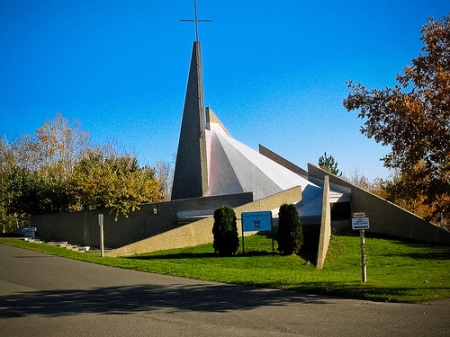| 
In the New Oxford Review, Michael Rose suggests that church architecture must be durable, evoke the heavenly and eternal, and bring the gospel to life. Wow. Three short phrases that are packed with meaning. Unfortunately, we do not pay much attention to this when we sit down to design a building to house the assembly of God's people for worship. I blame architects who impose their thinking or ideas upon churches and building committees so often driven by their slavery to the budget. But more than this, I fault our own confusion about what takes place in worship -- if we are not sure what takes place in the Divine Service, it stands to reason our buildings will reflect that confusion.
Rose says the building must be durable. Too often we build our buildings today with a view to a lifespan -- this is not something typical of churches only. We build them NOT to last and they show it. I am not strictly speaking of the materials we use but the idea of building a structure designed in a novel way or a trendy style as well as one constructed cheaply. Too many church buildings look like mirrors of a style in architecture that came and went. Unfortunately, these buildings remained and the congregation was forced then to live in a building that screams "fad." I think of buildings I have been in -- A frames, fish styled, round, concrete boxes, etc... They may have been fashionable in their day but they have saddled the people of God with a structure that has not grown over time but, instead, wears like a leisure suit in 2010.
Buildings must be durable because we speak of a God who is our help in ages past and our hope for years to come. The structures we raise must resemble this timeless God and changeless Christ. There is also a practical as well as spiritual reason for building durable structures. Congregations are notorious for not spending money on maintenance and cheaply built structures are cheap to build and costly to maintain. Either we will spend the money now to build credible buildings that will age well or we will spend our future on face lifts for sagging structures and time worn facades.
Rose says that buildings must evoke the heavenly and eternal. Look at the buildings we build and call "church" and tell me what those buildings say. Most of them speak not of God but of us. Our concern most of all is accessibility, comfort, and convenience. I would suggest that these are legitimate concerns but not the primary concerns. We need structures that cause us to look up, away from ourselves, and toward the God of the heavens who has come low to us in Christ. We need structures that emphasize our community gathered around the Word and Table of the Lord -- the central pieces of furniture must be central. I vote for a well placed and significantly sized cross and corpus (crucifix or, at least, a Christus Rex). The building must direct our attention to the place where water marks us for the kingdom, where God sets His table among us, and where the Word is proclaimed that the hearers might be saved.
It would seem that technology drives our structures more than anything else. This is a sad reality. We can use technology without worshiping at this idol altar. Christ must be central and just as the building must be durable and substantial, so the appointments of the Church must be durable and substantial. I vote against novelty (skip the odd shaped altars, fonts, and pulpits over something more timeless -- modern need not be strange or weird).
Rose says the buildings must bring the Gospel to life. Well, what brings the Gospel to us? What imparts to us the power of Christ's life, death, and resurrection? Surely this is an easy question for Lutherans to answer -- the Word and Sacraments. But why does it seem that the Word and Sacraments are not presupposed by those designing these structures? Why do we have chancels too crowded to be useful? Why do we have altar rails so small that the distribution is painfully slow and encumbered by restriction? Why do we have pulpits that are small and mobile (what the Word of God is NOT)? Why do we have structures not amenable to the sound of singing and music, to the voice of proclamation, and to the voice of praise? Acoustics are not a side issue but one of the ways a building is deemed successful or a failure in its purpose as the place for God's people to worship Him. Carpeting and odd shaped buildings work against sound and create the need for sound amplification. If the structure is well designed, sound may need to be reinforced for the sake of some voices, but it need not be amplified in order to be heard (choirs should never need to be miked).
We have a somewhat odd shaped structure (wider than it is deep) but it is traditional and modern at the same time. The acoustics are good and reinforce the music of the liturgy and the preaching that is the center of what we do on Sunday morning. The chancel is large and expansive. It is not perfect but it is not bad. If I would have had my druthers, I would have built something FR Weber would have approved of (his old monograph The Small Church is still a high point for church architecture, in my humble opinion). The appointments are solid and substantial. The stained glass is liturgical. I offer this not as a prototype but as an example of what we should be doing even as I speak of what we should not be doing... 
|
